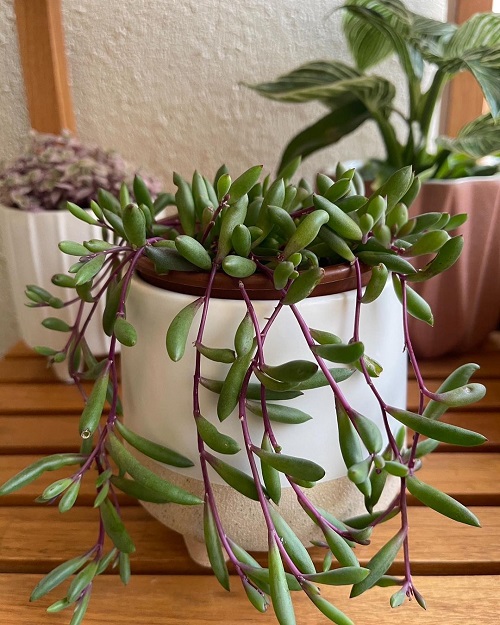Transform your living space into a lively spot with the beautiful String of Rubies. Learn all about Growing Ruby Necklace Indoors here!

Native to South Africa, String of Rubies makes for an amazing houseplant with its low-maintenance requirements. The plant produces small, daisy-like bright yellow flowers in the summer months, adding a pop of colors to the trailing stems. Learn all about Growing String of Rubies Indoors here!
String Of Rubies Plant Profile
The String of Rubies, also known as Ruby Necklace or String of Pickles, is a member of the Asteraceae family and is known for its trailing stems with a bold pink-burgundy hue. The stems are covered in small, bean-shaped succulent leaves that are a bright green color and can magically turn into a deep red hue in bright light.
The gorgeous vines can grow up to 6-12 inches (15-30 cm) long, with excellent drought-tolerant quality, making them a great option for indoor or outdoor container gardens. Additionally, the low demands combined with a captivating physical appearance make this plant the first choice of plant parents.
Ideal Pot Size
Get a pot that is one size bigger than the plant’s root ball. A 6 to 8 inches pot with 2-3 drainage holes is good enough for a young String of Rubies. As the plant grows, you may need to transplant it to a larger pot to accommodate its expanding root system.
The cascading vines of this beauty look fantastic in hanging baskets. Put on your creative hat and get a beautiful container—showy ceramics, woven pot covers, figurine pots, the options are endless.
String of Rubies Propagation

Propagating String of Rubies via stem cuttings is easy, following these simple steps:
- Get a healthy, disease-free plant and cut a healthy stem using sharp, sterile clippers just below a leaf node. Ensure the cutting is at least 4-6 inches long.
- Allow the cutting to callous over for a day or two to keep potential fungal issues away.
- Prepare a pot with a well-draining rooting medium and insert the cutting into it.
- Water the medium thoroughly and keep the soil slightly moist but not too wet. Be careful not to overwater, as this can lead to root rot.
- Keep the cutting in a warm and bright spot but out of direct sunlight.
It will take 2-3 weeks for the cutting to root and begin to grow. Be patient and avoid disturbing the cutting during this time.
Requirements for Growing Strings of Rubies Indoors

Light
To enjoy the glorious show of String of Rubies, expose the plant to as much direct sunlight as possible. Place the plant near your south-facing window that receives the bright afternoon sunlight. It will encourage the bean-shaped leaves to develop an exotic red color, while a lack of bright sunlight will fade its color to a dull green. However, if you find the leaves scorching, move the plant indoors or drape a curtain to filter sunlight.
It may benefit from supplemental artificial lighting, such as a grow light, especially during the winter months when natural light is limited.
Soil
String of Rubies prefers a sandy or gritty soil mix that allows for good drainage. A soil mix specifically formulated for cacti and succulents is ideal. The soil pH level should be slightly acidic from 6-6.5.
A good soil mix should contain equal parts of perlite, sand, pumice, and peat moss. This will provide a good balance of nutrients, aeration, and drainage. Alternatively, you may also use an orchid mix mixed with a fistful of perlite.
Water
Ruby Necklace is a drought-tolerant plant that stores water in its thick leaves. Overwatering can harm the plant, so it’s important to allow the soil to dry out between waterings. Follow a deep watering session every week, which means watering the soil until it seeps out of the drainage holes. Then follow the same when the soil is completely dry to the touch.
Temperature and Humidity
This trailing succulent is not a cold-hardy variety and prefers warm temperatures to thrive. Ideally, a range of 16-28 C or 60-82F is good for the plant. Temperatures below 10 C or 50 F will stunt its growth. Also, ensure to keep the plant away from cold or heat vents to avoid temperature fluctuations.
The String of Pickles will thrive in the typical household humidity. However, you may need to use a humidifier or a pebble tray to boost the moisture around your plant.
String of Rubies Care

Fertilizer
Use a balanced liquid fertilizer every 4-6 weeks, diluting to half its strength in the spring months. Being a succulent, the plant is not a heavy feeder, so it does not need regular fertilization. Also, ensure not to fertilize during the plant’s dormancy in the colder months.
Over-fertilizing can cause the plant to grow too quickly, which can result in weak and leggy growth or even salt burn in the worst cases. Apply the fertilizer to damp soil to prevent it from burning the plant’s roots.
Pests And Disease
The String of Rubies plant is a hardy succulent that is resistant to most pests and diseases. However, the plant might be susceptible to some common houseplant pests, including mealybugs, spider mites, scales, powdery mildew, leaf spot, and, most importantly—root rot.
They can be treated with neem oil or insecticidal soap spray every month or when your spot the infestation. Avoid overwatering and keep the plant well-aerated to keep potential issues at bay.






